
This is my own personal list of the top films of the 60's. It includes my own views, as well as views from e-mails, other critics and websites. I tried to include films from all the main genres; including, war, horror, sci-fi, romance, kid's, etc. As well as movies that were groundbreaking from a technology point of view or changed the industry in some way. I did not include foreign films. The top films are placed in alphabetical order. Each are great in their own way and would be quite difficult to arrange in a 1-20 list. The movie titles are linked to the IMDB (Internet Movie Database) which contains extra information on each film, including the cast and crew. To get back to my site from this link, you will need to use the "back" button. By viewing these 20 films, I believe you will have a great feel for what the American film was all about in the 60's.
The Apartment (1960)
 When I began making the 60's list, I came upon 2 great films starring Jack Lemmon and had to decide which to keep on my list. The first, "Days of Wine and Roses" (1962) is still one of the best Hollywood films to ever show the effects of Alcoholism and was an amazing serious acting role for Lemmon. The second is this film, "The Apartment". Jack Lemmon plays a vulnerable office worker trying to move up the ladder. His uncaring boss, played by Fred MacMurray, starts to help him along when Lemmon allows him to use his apartment for his extramarital affairs. Lemmon begins having problems when he starts falling for the young elevator operator (Shirley MacLaine in her first role) who's one of his bosses girlfriend. The movie has wonderful acting, but it's Billy Wilder who wrote and directed the film, that added the right touches of humor, drama and sadness. This film was one of the first film's to start testing the limits of the censory board. It helped that it used lots of humor to help make the issues of infidelity and attempted suicide seem less offensive. Writers and Directors would continue to push the boundaries and it's interesting to look at films near the end of the decade such as "The Graduate", "Who Afraid of Virginia Wolf", "The Wild Bunch" and "Midnight Cowboy", and how drastic things would change.
When I began making the 60's list, I came upon 2 great films starring Jack Lemmon and had to decide which to keep on my list. The first, "Days of Wine and Roses" (1962) is still one of the best Hollywood films to ever show the effects of Alcoholism and was an amazing serious acting role for Lemmon. The second is this film, "The Apartment". Jack Lemmon plays a vulnerable office worker trying to move up the ladder. His uncaring boss, played by Fred MacMurray, starts to help him along when Lemmon allows him to use his apartment for his extramarital affairs. Lemmon begins having problems when he starts falling for the young elevator operator (Shirley MacLaine in her first role) who's one of his bosses girlfriend. The movie has wonderful acting, but it's Billy Wilder who wrote and directed the film, that added the right touches of humor, drama and sadness. This film was one of the first film's to start testing the limits of the censory board. It helped that it used lots of humor to help make the issues of infidelity and attempted suicide seem less offensive. Writers and Directors would continue to push the boundaries and it's interesting to look at films near the end of the decade such as "The Graduate", "Who Afraid of Virginia Wolf", "The Wild Bunch" and "Midnight Cowboy", and how drastic things would change.
Bonnie and Clyde (1967)
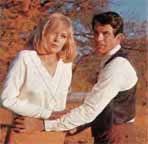 One of the themes recuring in films of the 60's was the depiction of the villian as a likable hero. Vietnam and Watergate had caused a disenchantment with the government, and anyone who rebelled with authority was seen as the good-guy by the younger generation. The characters of Bonnie and Clyde were seen as good looking, humorous and great fun to be around, even though they were theives. The audience came to root for the criminal and wish bad on the police or government. This can be seen in other films of the decade; Butch Cassidy and the Sundance Kid, Easy Rider, Psycho and the gangs in West Side Story. Warren Beatty and Faye Dunaway played Clyde Barrow and Bonnie Parker, the two real-life, depression era, bank robbers. The film follows the couples meeting, forming a small band of criminals (Gene Hackman, Estelle Parsons, Gene Wilder), their success and ultimate demise. The brutal climax of the film was quite controvesial. The ambush and slow motion gunning down of the lead characters were shocking even by today's standards. The gunfire massacre, as their bodies convulsed and explodes with blood, was one of the most graphic depictions of death seen on the movie screen.
One of the themes recuring in films of the 60's was the depiction of the villian as a likable hero. Vietnam and Watergate had caused a disenchantment with the government, and anyone who rebelled with authority was seen as the good-guy by the younger generation. The characters of Bonnie and Clyde were seen as good looking, humorous and great fun to be around, even though they were theives. The audience came to root for the criminal and wish bad on the police or government. This can be seen in other films of the decade; Butch Cassidy and the Sundance Kid, Easy Rider, Psycho and the gangs in West Side Story. Warren Beatty and Faye Dunaway played Clyde Barrow and Bonnie Parker, the two real-life, depression era, bank robbers. The film follows the couples meeting, forming a small band of criminals (Gene Hackman, Estelle Parsons, Gene Wilder), their success and ultimate demise. The brutal climax of the film was quite controvesial. The ambush and slow motion gunning down of the lead characters were shocking even by today's standards. The gunfire massacre, as their bodies convulsed and explodes with blood, was one of the most graphic depictions of death seen on the movie screen.
Butch Cassidy and the Sundance Kid (1969)
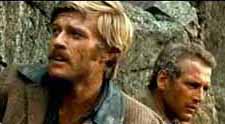 This film has many similiarities with the pervious movie "Bonnie and Clyde". The story follows two bankrobbers who are likable, funny and good-looking, played by two of the hottest stars of the day, Robert Redford and Paul Newman. The title characters are based on the real life 1890's train and bank robbers who terrorized the west until they were chased down to Bolivia and supposedly killed. The movie leaves this last point up in the air (no pun intended) with the film ending on a freeze frame of Butch and Sundance jumping over a cliff to escape. George Roy Hill directed this film which is part Western and part Comedy, with the hint of a love story thrown in, supplied by Katherine Ross who's in love with one of the bandits. The pieces of this film just work well together, especially the screenplay and cinematography, which both won Oscars, and the chrisma of the two male stars who just shine on the screen together.
This film has many similiarities with the pervious movie "Bonnie and Clyde". The story follows two bankrobbers who are likable, funny and good-looking, played by two of the hottest stars of the day, Robert Redford and Paul Newman. The title characters are based on the real life 1890's train and bank robbers who terrorized the west until they were chased down to Bolivia and supposedly killed. The movie leaves this last point up in the air (no pun intended) with the film ending on a freeze frame of Butch and Sundance jumping over a cliff to escape. George Roy Hill directed this film which is part Western and part Comedy, with the hint of a love story thrown in, supplied by Katherine Ross who's in love with one of the bandits. The pieces of this film just work well together, especially the screenplay and cinematography, which both won Oscars, and the chrisma of the two male stars who just shine on the screen together.
Doctor Zhivago (1965)
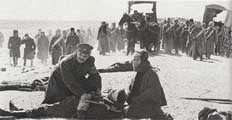
 This film has almost been bumped off a few times from this list, but as of now, it still remains. Mainly for it's appearance on other lists and because it is one of my mother's favorite films. A movie with epic proportions, it is your typical love story with a historical event as its backdrop. In this case it is a love triangle set during the Russian Revolution. Omar Sharif is a doctor/poet caught in the turmoil of the war and in love with two women, played by Julie Christie and Geraldine Chaplin. David Lean directed with his usual epic flair. Frederick Young won a deserved Oscar for cinematography. The whole picture is like eye candy with visuals of amazing beauty. Maurice Jarre also won an Oscar for the musical score, with the haunting "Lara's Theme" a classic melody from the cinema.
This film has almost been bumped off a few times from this list, but as of now, it still remains. Mainly for it's appearance on other lists and because it is one of my mother's favorite films. A movie with epic proportions, it is your typical love story with a historical event as its backdrop. In this case it is a love triangle set during the Russian Revolution. Omar Sharif is a doctor/poet caught in the turmoil of the war and in love with two women, played by Julie Christie and Geraldine Chaplin. David Lean directed with his usual epic flair. Frederick Young won a deserved Oscar for cinematography. The whole picture is like eye candy with visuals of amazing beauty. Maurice Jarre also won an Oscar for the musical score, with the haunting "Lara's Theme" a classic melody from the cinema.
Dr. Strangelove or : How I Learned to Stop Worrying and Love the Bomb (1964)
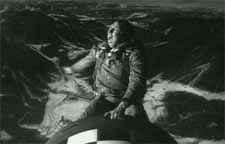
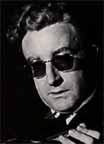 One of two Stanley Kubrick films that made my list. This wonderful black comedy deals with issues of the cold war and nuclear holocaust. A fanatical U.S. general takes over his own military base after he believes the "Commies" are stealing the body fluids of all Americans, and sets off a bombing strike on the Soviet Union. The U.S. government tries desperately to stop the attack before a nuclear war begins. Peter Sellers is brilliant playing three seperate roles, a straight British Officer trapped at the Army base, the apologetic President of the United States, and a mad German scientist, who's metal arm keeps flying up in the Nazi salute. The rest of the cast is just as good, including Sterling Hayden, George C. Scott, James Earl Jones and Slim Pickens, the Air Force Pilot who rides the bomb down yelping with his cowboy hat. One of the best comedies ever, but it's not a laugh out loud film. One way a writer can get laughs is by making jokes so close to the truth it becomes hard to tell if they are jokes or not. These aren't over the top hilarious one-liners, or grossout jokes, but the dark humor that sits with you for awhile and makes you ponder how bizarre life really is. Appears on both AFI's list of best films (#26) and funniest films.
One of two Stanley Kubrick films that made my list. This wonderful black comedy deals with issues of the cold war and nuclear holocaust. A fanatical U.S. general takes over his own military base after he believes the "Commies" are stealing the body fluids of all Americans, and sets off a bombing strike on the Soviet Union. The U.S. government tries desperately to stop the attack before a nuclear war begins. Peter Sellers is brilliant playing three seperate roles, a straight British Officer trapped at the Army base, the apologetic President of the United States, and a mad German scientist, who's metal arm keeps flying up in the Nazi salute. The rest of the cast is just as good, including Sterling Hayden, George C. Scott, James Earl Jones and Slim Pickens, the Air Force Pilot who rides the bomb down yelping with his cowboy hat. One of the best comedies ever, but it's not a laugh out loud film. One way a writer can get laughs is by making jokes so close to the truth it becomes hard to tell if they are jokes or not. These aren't over the top hilarious one-liners, or grossout jokes, but the dark humor that sits with you for awhile and makes you ponder how bizarre life really is. Appears on both AFI's list of best films (#26) and funniest films.
Easy Rider (1969)
 If I had to choose one film that depicted the 60's era, I think this would be the movie. The characters, story, music, the way it was filmed and even how it was made all symbolize the 60's ideals of freedom. The story centers around two drug dealing bikers, played by Peter Fonda and Dennis Hopper, who decide to bike from the west coast to Mardi Gras in New Orleans. They want to discover America and feel the freedom of riding their bikes. They make friends with a crazed lawyer, played by Jack Nicholson and a peaceful commune of free loving hippees. But they also learn they are not welcome in many places and this discrimination leads to a shocking conclusion. This movie was one of the first independent films to buck the Hollywood system, being made for only $? The film was also unique using popular music of the time and the cinematography was groundbreaking by using natural settings and people, filming on location across the Southern United States. It became the ultimate biker film that started a movie fad. It appears on AFI's list of best films at #88.
If I had to choose one film that depicted the 60's era, I think this would be the movie. The characters, story, music, the way it was filmed and even how it was made all symbolize the 60's ideals of freedom. The story centers around two drug dealing bikers, played by Peter Fonda and Dennis Hopper, who decide to bike from the west coast to Mardi Gras in New Orleans. They want to discover America and feel the freedom of riding their bikes. They make friends with a crazed lawyer, played by Jack Nicholson and a peaceful commune of free loving hippees. But they also learn they are not welcome in many places and this discrimination leads to a shocking conclusion. This movie was one of the first independent films to buck the Hollywood system, being made for only $? The film was also unique using popular music of the time and the cinematography was groundbreaking by using natural settings and people, filming on location across the Southern United States. It became the ultimate biker film that started a movie fad. It appears on AFI's list of best films at #88.
The Graduate (1967)
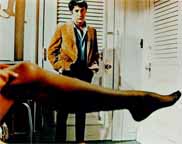
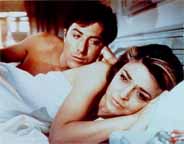 This is one of those films that everything is just perfect. The right cast, script, director, soundtrack and era that it was released. Dustin Hoffman plays a grad student who's seduced by an older, married friend of the family, Mrs. Robinson, played by Anne Bancroft. Hoffman's innocence comes through with both the seduction and as he begins to fall in love with Robinson's daughter. The script was as much of a drama as it was a comedy and made a star out of Hoffman. Simon and Garfunkel wrote and performed the memorable soundtrack, and it became Mike Nichols best directed films. Although I believe this is a good film and quite important, I don't think it deserves the huge praise and high ranking on the AFI list at #7. I think this became an important and personal film to many people growing up in the 60's, the same way "Star Wars" was for those in the 70's, but it's impact on film is no more important then "Easy Rider", "Guess Who's Coming to Dinner" or any movie on this list. A little overrated in my belief.
This is one of those films that everything is just perfect. The right cast, script, director, soundtrack and era that it was released. Dustin Hoffman plays a grad student who's seduced by an older, married friend of the family, Mrs. Robinson, played by Anne Bancroft. Hoffman's innocence comes through with both the seduction and as he begins to fall in love with Robinson's daughter. The script was as much of a drama as it was a comedy and made a star out of Hoffman. Simon and Garfunkel wrote and performed the memorable soundtrack, and it became Mike Nichols best directed films. Although I believe this is a good film and quite important, I don't think it deserves the huge praise and high ranking on the AFI list at #7. I think this became an important and personal film to many people growing up in the 60's, the same way "Star Wars" was for those in the 70's, but it's impact on film is no more important then "Easy Rider", "Guess Who's Coming to Dinner" or any movie on this list. A little overrated in my belief.
Guess Who's Coming to Dinner (1967)
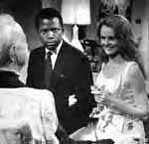 One of the most important issues that marked the 60's decade was the civil rights movement and this movie, far ahead of it's time, tried to tackle a small sample of this topic. When a young, white woman arrives home to introduce her new fiance to her parents, she has yet to inform them that he's black. The film follows the young couple revealing this important fact to both sets of parents and the dinner party that follows as all the characters try to deal with the issues of interracial marriage. There are two important facts that make this film work so well. The first is the screenplay. William Rose won the Oscar for the script that carefully dealt with the issue from all points of view and made each of the characters intelligent and likable. The second is the cast which garnered four Oscar nominations for acting (One win for best actress). This was the last film that teamed Katherine Hepburn with Spencer Tracy. The classic Hollywood duo was the perfect couple to bring the issues of interracial relationships to white America. Their daughter was played sweetly by Hepburn's real life neice, Katherine Houghton. Sidney Poitier played the suitor. His presence on the screen is one of power, pride and love for both his soon to be wife and his parents. Again, Potier was the perfect (and possible the only) actor that the 60's audiences would accept in this situation. His parents were played equally well by Cecil Kellaway and Beah Richards who kept their own on screen with Tracy and Hepburn. The film appears on the AFI list of best films at #99, but I don't think it belongs on the list. Too many films are missing from the list that are better than this movie.
One of the most important issues that marked the 60's decade was the civil rights movement and this movie, far ahead of it's time, tried to tackle a small sample of this topic. When a young, white woman arrives home to introduce her new fiance to her parents, she has yet to inform them that he's black. The film follows the young couple revealing this important fact to both sets of parents and the dinner party that follows as all the characters try to deal with the issues of interracial marriage. There are two important facts that make this film work so well. The first is the screenplay. William Rose won the Oscar for the script that carefully dealt with the issue from all points of view and made each of the characters intelligent and likable. The second is the cast which garnered four Oscar nominations for acting (One win for best actress). This was the last film that teamed Katherine Hepburn with Spencer Tracy. The classic Hollywood duo was the perfect couple to bring the issues of interracial relationships to white America. Their daughter was played sweetly by Hepburn's real life neice, Katherine Houghton. Sidney Poitier played the suitor. His presence on the screen is one of power, pride and love for both his soon to be wife and his parents. Again, Potier was the perfect (and possible the only) actor that the 60's audiences would accept in this situation. His parents were played equally well by Cecil Kellaway and Beah Richards who kept their own on screen with Tracy and Hepburn. The film appears on the AFI list of best films at #99, but I don't think it belongs on the list. Too many films are missing from the list that are better than this movie.
A Hard Day's Night (1964)
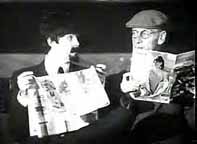
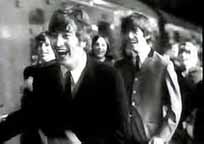 One of the growing trends of the 60's decade was the rise of rock-n-roll music in pop culture, and one of the biggest influences on the direction of this music and the 60's in general was "The Beatles". It continues to boggle my mind that the Beatles were only together for seven years, yet they changed their musical style, their look, recorded hundreds of songs and experimented with movies. "A Hard Day's Night" was to introduce American audiences to the fab four by showing a day in the life of the group. Director Richard Lester used the Beatles natural sense of humor and musical talent to string together slapstick jokes and puns with energetic concert performances. The natural charisma and humor that John, Paul, George, and Ringo brought to the screen made them even bigger stars than before. The group would experiment more with film, "Help" (65), Magical Mystery Tour (), and Yellow Submarine (68), but it was this film that is frequently sited as the birthplace of the music videos.
One of the growing trends of the 60's decade was the rise of rock-n-roll music in pop culture, and one of the biggest influences on the direction of this music and the 60's in general was "The Beatles". It continues to boggle my mind that the Beatles were only together for seven years, yet they changed their musical style, their look, recorded hundreds of songs and experimented with movies. "A Hard Day's Night" was to introduce American audiences to the fab four by showing a day in the life of the group. Director Richard Lester used the Beatles natural sense of humor and musical talent to string together slapstick jokes and puns with energetic concert performances. The natural charisma and humor that John, Paul, George, and Ringo brought to the screen made them even bigger stars than before. The group would experiment more with film, "Help" (65), Magical Mystery Tour (), and Yellow Submarine (68), but it was this film that is frequently sited as the birthplace of the music videos.
Lawrence of Arabia (1962)
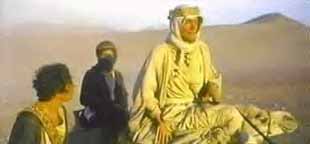
 This epic cinematic masterpeice follows T.E. Lawerence, a WWI British military officer dispatched to Arabia. He decides to stay in the area and become a dessert warrior, who begins to break through century-old rivalries between the Arabs and unite them against the Turks. Peter O'Toole was spectacular playing the bleach blond, Messiah-like lead dressed in flowing white robes. He was backed by a who's who of top actors; Omar Sharif, Claude Rains, Anthony Quinn and Alec Guinness. Besides from the acting, David Lean's direction and cinematographer, Frederick Young, were able to photograph the beauty of the desert, the huge crowd scenes and massive battle sequences. One of my cinematic dreams is to see this film on the big screen. I can only imagine what the beautiful, sweeping landscapes of the desert will look like flowing across a theater wall. This classic appears on AFI's list of best films at #5.
This epic cinematic masterpeice follows T.E. Lawerence, a WWI British military officer dispatched to Arabia. He decides to stay in the area and become a dessert warrior, who begins to break through century-old rivalries between the Arabs and unite them against the Turks. Peter O'Toole was spectacular playing the bleach blond, Messiah-like lead dressed in flowing white robes. He was backed by a who's who of top actors; Omar Sharif, Claude Rains, Anthony Quinn and Alec Guinness. Besides from the acting, David Lean's direction and cinematographer, Frederick Young, were able to photograph the beauty of the desert, the huge crowd scenes and massive battle sequences. One of my cinematic dreams is to see this film on the big screen. I can only imagine what the beautiful, sweeping landscapes of the desert will look like flowing across a theater wall. This classic appears on AFI's list of best films at #5.
The Manchurian Candidate (1962)
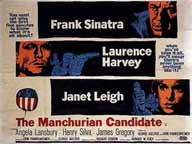
 One of the first and best political thrillers. Laurence Harvey plays a Korean POW who returns home to a hero's welcome. Little do we know that his captors have brainwashed and reprogrammed him to assassinate a key political figure. Only Frank Sinatra, a fellow brainwashed soldier, suspects that things are not quite right, and races with the clock before the timebomb goes off. Angela Lansbury was wonderful as Harvey's mother (only 3 years older in real life). A sweet woman who is really in on the plot. John Frankenheimer directed an edge of your seat thriller with overtones of political satire and social commentary. The film also had many similarities to the Kennedy assassination which would happen a year later.
One of the first and best political thrillers. Laurence Harvey plays a Korean POW who returns home to a hero's welcome. Little do we know that his captors have brainwashed and reprogrammed him to assassinate a key political figure. Only Frank Sinatra, a fellow brainwashed soldier, suspects that things are not quite right, and races with the clock before the timebomb goes off. Angela Lansbury was wonderful as Harvey's mother (only 3 years older in real life). A sweet woman who is really in on the plot. John Frankenheimer directed an edge of your seat thriller with overtones of political satire and social commentary. The film also had many similarities to the Kennedy assassination which would happen a year later.
Mary Poppins (1964)
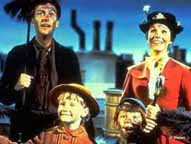 The wonderful story of a family in need of some magic. A very proper British family needs to hire a new nanny and the mysterious Poppins floats to their aid. Mary, with the help of her chimney sweeping friend Bert (played joyfully by Dick Van Dyck), takes the two children on a magical journey through chalk paintings, Merry-Go-Round Horse races, and to the roofs of London. Mary Poppins ends up teaching the entire family lessons on money, love and the importance of family, before she heads on her way. The whole movie is filled with wonderful song and dance numbers impossible not to hum afterwards. The world inside the chalk paintings is one of the reasons movies are made. The technique of combining live action and animation was nothing new, in fact some of Disney's first films used this process (A series called "Alice in Wonderland"). But the Disney Studio created a magical realm with lovable creatures and vivid colors beyond what we've seen before. The dance with Bert and a group of penguins makes me smile every time. Julie Andrews took the role of Mary Poppins after the role of Eliza Doolittle, from "My Fair Lady" (a role she created on Broadway) went to Audrey Hepburn. It was a blessing for this movie, and in my view, a problem for the other. The Academy recognized this radiant new actress and gave Andrews the Oscar for Best Actress.
The wonderful story of a family in need of some magic. A very proper British family needs to hire a new nanny and the mysterious Poppins floats to their aid. Mary, with the help of her chimney sweeping friend Bert (played joyfully by Dick Van Dyck), takes the two children on a magical journey through chalk paintings, Merry-Go-Round Horse races, and to the roofs of London. Mary Poppins ends up teaching the entire family lessons on money, love and the importance of family, before she heads on her way. The whole movie is filled with wonderful song and dance numbers impossible not to hum afterwards. The world inside the chalk paintings is one of the reasons movies are made. The technique of combining live action and animation was nothing new, in fact some of Disney's first films used this process (A series called "Alice in Wonderland"). But the Disney Studio created a magical realm with lovable creatures and vivid colors beyond what we've seen before. The dance with Bert and a group of penguins makes me smile every time. Julie Andrews took the role of Mary Poppins after the role of Eliza Doolittle, from "My Fair Lady" (a role she created on Broadway) went to Audrey Hepburn. It was a blessing for this movie, and in my view, a problem for the other. The Academy recognized this radiant new actress and gave Andrews the Oscar for Best Actress.
Midnight Cowboy (1969)
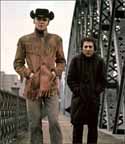 It's hard to believe that only two years have passed since Dustin Hoffman appeared in "The Graduate". Viewing this film is like seeing an actor 10 years later. Hoffman plays Rizzo (the rat), a seedy street urchin who develops an unusal friendship with a Texan, played by Jon Voight. They try to live and hustle around the darker sections of New York City. The only "X" rated film to win or be nominated for the Best Picture Oscar (although the film would recieve an "R" by today's standard). The screenplay also won the Oscar and the actors, including Sylvia Miles, were all outstanding and each received nominations. Decades later, the film is still an engrossing, sociological drama that is a must see. Listed on the AFI list at #36.
It's hard to believe that only two years have passed since Dustin Hoffman appeared in "The Graduate". Viewing this film is like seeing an actor 10 years later. Hoffman plays Rizzo (the rat), a seedy street urchin who develops an unusal friendship with a Texan, played by Jon Voight. They try to live and hustle around the darker sections of New York City. The only "X" rated film to win or be nominated for the Best Picture Oscar (although the film would recieve an "R" by today's standard). The screenplay also won the Oscar and the actors, including Sylvia Miles, were all outstanding and each received nominations. Decades later, the film is still an engrossing, sociological drama that is a must see. Listed on the AFI list at #36.
Psycho (1960)

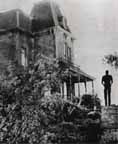 An Absolute Masterpiece!! One of the most perfectly made motion pictures ever! I had a film professor at college that said she could teach an entire semester course on this one film and I believe her. Hitchcock has crafted this movie with so many little clues dealing with the story that you can almost feel him snickering behind the camera. The story begins with a young woman, Marion Crane stealing some insurance money to begin a new life with her boyfriend. After driving all night through a rainstorm, she ends up at the Bates Motel and rents a room. She meets the hotel manager, Norman, and they have a small conversation before she heads off to the shower. While in the shower she is brutal murdered. Norman discovers Marion's body and realizing his "mother" commited the crime, tries to do everything to cover up the murder. Marion's sister, boyfriend and a private detective soon arrive at the motel to solve her disappearance and the mystery behind the crime. Hitchcock did many unheard of tactics including killing off his star a third of the way through the picture, and restricting anyone from entering the theater once the picture started. These were partically marketing tools, but there was also meaning behind both. The film toys with the way an audience feels about each character. If a person missed the beginning of the film, their emotions to the players change. And by killing off the star, Hitchcock made the crime that much more shocking. The shower scene is a classic of cinema history; the editing, shrieking music, camera angles, etc. And all without ever seeing the knife cut the person. Something slasher films seem to forget! Appears on AFI's list of best films at #18 and as the #1 film on their Thiller List.
An Absolute Masterpiece!! One of the most perfectly made motion pictures ever! I had a film professor at college that said she could teach an entire semester course on this one film and I believe her. Hitchcock has crafted this movie with so many little clues dealing with the story that you can almost feel him snickering behind the camera. The story begins with a young woman, Marion Crane stealing some insurance money to begin a new life with her boyfriend. After driving all night through a rainstorm, she ends up at the Bates Motel and rents a room. She meets the hotel manager, Norman, and they have a small conversation before she heads off to the shower. While in the shower she is brutal murdered. Norman discovers Marion's body and realizing his "mother" commited the crime, tries to do everything to cover up the murder. Marion's sister, boyfriend and a private detective soon arrive at the motel to solve her disappearance and the mystery behind the crime. Hitchcock did many unheard of tactics including killing off his star a third of the way through the picture, and restricting anyone from entering the theater once the picture started. These were partically marketing tools, but there was also meaning behind both. The film toys with the way an audience feels about each character. If a person missed the beginning of the film, their emotions to the players change. And by killing off the star, Hitchcock made the crime that much more shocking. The shower scene is a classic of cinema history; the editing, shrieking music, camera angles, etc. And all without ever seeing the knife cut the person. Something slasher films seem to forget! Appears on AFI's list of best films at #18 and as the #1 film on their Thiller List.
Rosemary's Baby (1968)
 I only recently saw this film, but was quite haunted by the acting. Roman Polanski directed this classic horror story of a woman who may be pregnant with Satan's baby. A young couple, played by Mia Farrow and John Cassavetes, move into a new apartment that may have been the home to a former witch. The husband, who's an actor, is having problems finding work. But after meeting the friendly, elderly couple next door, his luck begins to change. After a late night party, the young woman has a nightmare of an ancient ritual and a scary beast. She soon learns she's pregnant. Is this just a coincedence or is it something to trully be afraid of? Ruth Gordon won an Oscar playing the old lady from next door who could eerily remind you of someone you know. Polanski's storytelling and camera angles always kept you guessing on what was the truth, and the climax lets you question how much a mother would do for her son. Was the stepping stone to "The Exorcist" in the 70's.
I only recently saw this film, but was quite haunted by the acting. Roman Polanski directed this classic horror story of a woman who may be pregnant with Satan's baby. A young couple, played by Mia Farrow and John Cassavetes, move into a new apartment that may have been the home to a former witch. The husband, who's an actor, is having problems finding work. But after meeting the friendly, elderly couple next door, his luck begins to change. After a late night party, the young woman has a nightmare of an ancient ritual and a scary beast. She soon learns she's pregnant. Is this just a coincedence or is it something to trully be afraid of? Ruth Gordon won an Oscar playing the old lady from next door who could eerily remind you of someone you know. Polanski's storytelling and camera angles always kept you guessing on what was the truth, and the climax lets you question how much a mother would do for her son. Was the stepping stone to "The Exorcist" in the 70's.
The Sound of Music (1965)
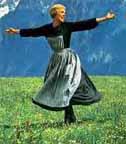
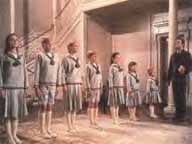 There are certain musicals adapted to the screen that don't do much for the play (ex. "Man of La Mancha"), or are not the definitive versions (Sorry, but I'm not a big fan of "My Fair Lady". The art production overshadows the rest of the picture). But this film is perfection. Everything about this movie is right, nothing needs to be changed. Not only does it beautifully give us the play, but it adds it's own identity with amazing cinematography, wonderful sets (that don't overpower) and a splendid cast. The story centers around a somewhat absent-minded nun who is assigned to be a governess to a family of 7 children. Their military father and the kids are soon won over by Marie as she brings love and music back into the household. But this new found happiness is soon shattered, when they must flee from the Nazi invasion of Austria. Robert Wise does just the right things with his direction and the Rogers and Hammerstein music is wonderful. They even added a few new songs for the film. Julie Andrews shines as Marie following in her role as Mary Poppins. Up there with "Wizard of Oz" as great family entertainment!
There are certain musicals adapted to the screen that don't do much for the play (ex. "Man of La Mancha"), or are not the definitive versions (Sorry, but I'm not a big fan of "My Fair Lady". The art production overshadows the rest of the picture). But this film is perfection. Everything about this movie is right, nothing needs to be changed. Not only does it beautifully give us the play, but it adds it's own identity with amazing cinematography, wonderful sets (that don't overpower) and a splendid cast. The story centers around a somewhat absent-minded nun who is assigned to be a governess to a family of 7 children. Their military father and the kids are soon won over by Marie as she brings love and music back into the household. But this new found happiness is soon shattered, when they must flee from the Nazi invasion of Austria. Robert Wise does just the right things with his direction and the Rogers and Hammerstein music is wonderful. They even added a few new songs for the film. Julie Andrews shines as Marie following in her role as Mary Poppins. Up there with "Wizard of Oz" as great family entertainment!
To Kill A Mockingbird (1962)
 Taken from the classic Harper Lee book of the same name, the story shows a glimpse of the racial problems of the Southern United States in the 1950's. Gregory Peck is one of the main reasons this film works so well. Peck, one of those All-American actors, plays Atticus Finch, an Alabama lawyer, who is asked to defend a black man accused of raping a young white woman. As the trail progresses, it becomes very clear that the handicapped black man couldn't have committed the crime and the woman's alcoholic father is probably to blame. But the all white jury points its finger at the black man with deadly consequences. The story is seen through the eyes of the lawyer's children, especally his daughter Scout. The three children had very little acting experience, but were quite exceptional. The film was also the screen debut of Robert Duvall, who played a completely silent role. The film was highly controversial when it opened, but both the book and this great adaption are now classics. Appears on AFI's list of best films at #34.
Taken from the classic Harper Lee book of the same name, the story shows a glimpse of the racial problems of the Southern United States in the 1950's. Gregory Peck is one of the main reasons this film works so well. Peck, one of those All-American actors, plays Atticus Finch, an Alabama lawyer, who is asked to defend a black man accused of raping a young white woman. As the trail progresses, it becomes very clear that the handicapped black man couldn't have committed the crime and the woman's alcoholic father is probably to blame. But the all white jury points its finger at the black man with deadly consequences. The story is seen through the eyes of the lawyer's children, especally his daughter Scout. The three children had very little acting experience, but were quite exceptional. The film was also the screen debut of Robert Duvall, who played a completely silent role. The film was highly controversial when it opened, but both the book and this great adaption are now classics. Appears on AFI's list of best films at #34.
2001: A Space Odyssey (1968)
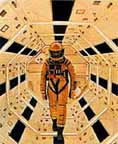
 One of the few films that is just hard to explain, but is considered one of the true cinematic masterpieces. Based on an Arthur C. Clarke story, Stanley Kubrick brought his own vision (as he always does) to direct this science fiction story that starts at the beginning of mankind. As an ape-man creates the first tools, a bone is thrown into the air and disolves into a rotating spaceship. Now in the future, the story tells of a strange monolith that has been discovered on the surface of the moon. This leads to a similiar object orbiting Jupiter. A probe is sent to investigate carrying three astronauts and one of the best villians in movie history, HAL the computer. Men begin to die and the mystery just becomes more confusing. The film ends in a psychedelic light show that was rather appropriate for the 60's. Kubrick used very little dialogue, letting his visuals tell the story. A good example of this was the wonderful way he showed HAL, seen only by a red light for an eye, reading the lips of the crewmembers who are planning on shutting down the computer. The film raises more questions than answers, but that's one of the wonderful concepts of the film. The use of classic music for the soundtrack would forever change our view of Richard Strauss and Johann Strauss. On AFI's list of best films at #22.
One of the few films that is just hard to explain, but is considered one of the true cinematic masterpieces. Based on an Arthur C. Clarke story, Stanley Kubrick brought his own vision (as he always does) to direct this science fiction story that starts at the beginning of mankind. As an ape-man creates the first tools, a bone is thrown into the air and disolves into a rotating spaceship. Now in the future, the story tells of a strange monolith that has been discovered on the surface of the moon. This leads to a similiar object orbiting Jupiter. A probe is sent to investigate carrying three astronauts and one of the best villians in movie history, HAL the computer. Men begin to die and the mystery just becomes more confusing. The film ends in a psychedelic light show that was rather appropriate for the 60's. Kubrick used very little dialogue, letting his visuals tell the story. A good example of this was the wonderful way he showed HAL, seen only by a red light for an eye, reading the lips of the crewmembers who are planning on shutting down the computer. The film raises more questions than answers, but that's one of the wonderful concepts of the film. The use of classic music for the soundtrack would forever change our view of Richard Strauss and Johann Strauss. On AFI's list of best films at #22.
West Side Story (1961)
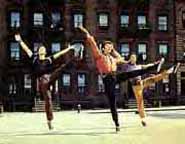
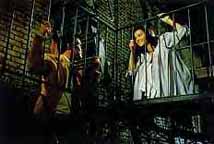 Taken from the Broadway classic, the story is an adaption of Shakespeare's "Romeo and Juliet" set among New York City street gangs of the 1950's. Leonard Bernstein's score, changed little from the orginal, is wonderful. One of the top five musical scores of the 20th century. Another highlight is Jerome Robbins choreography which earned a deserved special award. I always had a little problem with the lead roles played by Natalie Wood and Richard Beymer. The corny accent Wood tries to pull off is always a distraction and no matter how good lip-synching was, you can tell she's not singing those songs. Beymer just doesn't fit the part of Tony for me. The other actors are right on the mark. Especially Rita Moreno and George Chakiris who both won Oscars in the best supporting actor category. You can tell they are having a blast together singing and dancing through, "America". Robert Wise directed this classic musical and would do it again in a few years with "Sound of Music". Appears on the AFI list of best movies at #41.
Taken from the Broadway classic, the story is an adaption of Shakespeare's "Romeo and Juliet" set among New York City street gangs of the 1950's. Leonard Bernstein's score, changed little from the orginal, is wonderful. One of the top five musical scores of the 20th century. Another highlight is Jerome Robbins choreography which earned a deserved special award. I always had a little problem with the lead roles played by Natalie Wood and Richard Beymer. The corny accent Wood tries to pull off is always a distraction and no matter how good lip-synching was, you can tell she's not singing those songs. Beymer just doesn't fit the part of Tony for me. The other actors are right on the mark. Especially Rita Moreno and George Chakiris who both won Oscars in the best supporting actor category. You can tell they are having a blast together singing and dancing through, "America". Robert Wise directed this classic musical and would do it again in a few years with "Sound of Music". Appears on the AFI list of best movies at #41.
The Wild Bunch (1969)
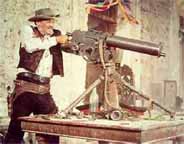
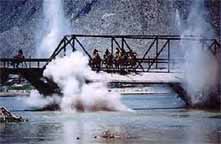 Sam Peckinpah directed this dramatic and violent tale set during the early 1900's about the dieing days of the cowboys and the Old West. It tells the tale of the "Wild Bunch", a group of aging outlaws who seem to have come to the end of the line because of their age and the changes in the West. The film opens with the bunch deciding to pull off one final bank heist, but during their attempt, they are ambushed and a huge battle takes place, the scale of which would be a normal climax for most films. The group is chased by the law until the film ends with another brutal battle with a Mexican warlord over a double-crossing arms deal. Taking a piece from "Bonnie and Clyde's" climatic, slow-motion massacre, Peckinpah used extremely graphic, slow-motion gun fighting to show the horrors that bullets can have on the human body. The continuous splatting of blood becomes a bizarre, aesthetic image and would set the standard for movie violence to follow. Nothing like this would ever be seen at the beginning of the decade. It also held the record for the most edits by any film up to this time. Considered one of the classics in the Western genre, it's a vastly different film from "Butch Cassidy and the Sundance Kid" which was released the same year. It won no awards, but appears on AFI's list of best films at #80.
Sam Peckinpah directed this dramatic and violent tale set during the early 1900's about the dieing days of the cowboys and the Old West. It tells the tale of the "Wild Bunch", a group of aging outlaws who seem to have come to the end of the line because of their age and the changes in the West. The film opens with the bunch deciding to pull off one final bank heist, but during their attempt, they are ambushed and a huge battle takes place, the scale of which would be a normal climax for most films. The group is chased by the law until the film ends with another brutal battle with a Mexican warlord over a double-crossing arms deal. Taking a piece from "Bonnie and Clyde's" climatic, slow-motion massacre, Peckinpah used extremely graphic, slow-motion gun fighting to show the horrors that bullets can have on the human body. The continuous splatting of blood becomes a bizarre, aesthetic image and would set the standard for movie violence to follow. Nothing like this would ever be seen at the beginning of the decade. It also held the record for the most edits by any film up to this time. Considered one of the classics in the Western genre, it's a vastly different film from "Butch Cassidy and the Sundance Kid" which was released the same year. It won no awards, but appears on AFI's list of best films at #80.
| |
|
|
Great Movie Moments from the Decade
To the MOVIES Homepage


 When I began making the 60's list, I came upon 2 great films starring Jack Lemmon and had to decide which to keep on my list. The first, "Days of Wine and Roses" (1962) is still one of the best Hollywood films to ever show the effects of Alcoholism and was an amazing serious acting role for Lemmon. The second is this film, "The Apartment". Jack Lemmon plays a vulnerable office worker trying to move up the ladder. His uncaring boss, played by Fred MacMurray, starts to help him along when Lemmon allows him to use his apartment for his extramarital affairs. Lemmon begins having problems when he starts falling for the young elevator operator (Shirley MacLaine in her first role) who's one of his bosses girlfriend. The movie has wonderful acting, but it's Billy Wilder who wrote and directed the film, that added the right touches of humor, drama and sadness. This film was one of the first film's to start testing the limits of the censory board. It helped that it used lots of humor to help make the issues of infidelity and attempted suicide seem less offensive. Writers and Directors would continue to push the boundaries and it's interesting to look at films near the end of the decade such as "The Graduate", "Who Afraid of Virginia Wolf", "The Wild Bunch" and "Midnight Cowboy", and how drastic things would change.
When I began making the 60's list, I came upon 2 great films starring Jack Lemmon and had to decide which to keep on my list. The first, "Days of Wine and Roses" (1962) is still one of the best Hollywood films to ever show the effects of Alcoholism and was an amazing serious acting role for Lemmon. The second is this film, "The Apartment". Jack Lemmon plays a vulnerable office worker trying to move up the ladder. His uncaring boss, played by Fred MacMurray, starts to help him along when Lemmon allows him to use his apartment for his extramarital affairs. Lemmon begins having problems when he starts falling for the young elevator operator (Shirley MacLaine in her first role) who's one of his bosses girlfriend. The movie has wonderful acting, but it's Billy Wilder who wrote and directed the film, that added the right touches of humor, drama and sadness. This film was one of the first film's to start testing the limits of the censory board. It helped that it used lots of humor to help make the issues of infidelity and attempted suicide seem less offensive. Writers and Directors would continue to push the boundaries and it's interesting to look at films near the end of the decade such as "The Graduate", "Who Afraid of Virginia Wolf", "The Wild Bunch" and "Midnight Cowboy", and how drastic things would change.
 One of the themes recuring in films of the 60's was the depiction of the villian as a likable hero. Vietnam and Watergate had caused a disenchantment with the government, and anyone who rebelled with authority was seen as the good-guy by the younger generation. The characters of Bonnie and Clyde were seen as good looking, humorous and great fun to be around, even though they were theives. The audience came to root for the criminal and wish bad on the police or government. This can be seen in other films of the decade; Butch Cassidy and the Sundance Kid, Easy Rider, Psycho and the gangs in West Side Story. Warren Beatty and Faye Dunaway played Clyde Barrow and Bonnie Parker, the two real-life, depression era, bank robbers. The film follows the couples meeting, forming a small band of criminals (Gene Hackman, Estelle Parsons, Gene Wilder), their success and ultimate demise. The brutal climax of the film was quite controvesial. The ambush and slow motion gunning down of the lead characters were shocking even by today's standards. The gunfire massacre, as their bodies convulsed and explodes with blood, was one of the most graphic depictions of death seen on the movie screen.
One of the themes recuring in films of the 60's was the depiction of the villian as a likable hero. Vietnam and Watergate had caused a disenchantment with the government, and anyone who rebelled with authority was seen as the good-guy by the younger generation. The characters of Bonnie and Clyde were seen as good looking, humorous and great fun to be around, even though they were theives. The audience came to root for the criminal and wish bad on the police or government. This can be seen in other films of the decade; Butch Cassidy and the Sundance Kid, Easy Rider, Psycho and the gangs in West Side Story. Warren Beatty and Faye Dunaway played Clyde Barrow and Bonnie Parker, the two real-life, depression era, bank robbers. The film follows the couples meeting, forming a small band of criminals (Gene Hackman, Estelle Parsons, Gene Wilder), their success and ultimate demise. The brutal climax of the film was quite controvesial. The ambush and slow motion gunning down of the lead characters were shocking even by today's standards. The gunfire massacre, as their bodies convulsed and explodes with blood, was one of the most graphic depictions of death seen on the movie screen.
 This film has many similiarities with the pervious movie "Bonnie and Clyde". The story follows two bankrobbers who are likable, funny and good-looking, played by two of the hottest stars of the day, Robert Redford and Paul Newman. The title characters are based on the real life 1890's train and bank robbers who terrorized the west until they were chased down to Bolivia and supposedly killed. The movie leaves this last point up in the air (no pun intended) with the film ending on a freeze frame of Butch and Sundance jumping over a cliff to escape. George Roy Hill directed this film which is part Western and part Comedy, with the hint of a love story thrown in, supplied by Katherine Ross who's in love with one of the bandits. The pieces of this film just work well together, especially the screenplay and cinematography, which both won Oscars, and the chrisma of the two male stars who just shine on the screen together.
This film has many similiarities with the pervious movie "Bonnie and Clyde". The story follows two bankrobbers who are likable, funny and good-looking, played by two of the hottest stars of the day, Robert Redford and Paul Newman. The title characters are based on the real life 1890's train and bank robbers who terrorized the west until they were chased down to Bolivia and supposedly killed. The movie leaves this last point up in the air (no pun intended) with the film ending on a freeze frame of Butch and Sundance jumping over a cliff to escape. George Roy Hill directed this film which is part Western and part Comedy, with the hint of a love story thrown in, supplied by Katherine Ross who's in love with one of the bandits. The pieces of this film just work well together, especially the screenplay and cinematography, which both won Oscars, and the chrisma of the two male stars who just shine on the screen together.
 This film has almost been bumped off a few times from this list, but as of now, it still remains. Mainly for it's appearance on other lists and because it is one of my mother's favorite films. A movie with epic proportions, it is your typical love story with a historical event as its backdrop. In this case it is a love triangle set during the Russian Revolution. Omar Sharif is a doctor/poet caught in the turmoil of the war and in love with two women, played by Julie Christie and Geraldine Chaplin. David Lean directed with his usual epic flair. Frederick Young won a deserved Oscar for cinematography. The whole picture is like eye candy with visuals of amazing beauty. Maurice Jarre also won an Oscar for the musical score, with the haunting "Lara's Theme" a classic melody from the cinema.
This film has almost been bumped off a few times from this list, but as of now, it still remains. Mainly for it's appearance on other lists and because it is one of my mother's favorite films. A movie with epic proportions, it is your typical love story with a historical event as its backdrop. In this case it is a love triangle set during the Russian Revolution. Omar Sharif is a doctor/poet caught in the turmoil of the war and in love with two women, played by Julie Christie and Geraldine Chaplin. David Lean directed with his usual epic flair. Frederick Young won a deserved Oscar for cinematography. The whole picture is like eye candy with visuals of amazing beauty. Maurice Jarre also won an Oscar for the musical score, with the haunting "Lara's Theme" a classic melody from the cinema.
 One of two Stanley Kubrick films that made my list. This wonderful black comedy deals with issues of the cold war and nuclear holocaust. A fanatical U.S. general takes over his own military base after he believes the "Commies" are stealing the body fluids of all Americans, and sets off a bombing strike on the Soviet Union. The U.S. government tries desperately to stop the attack before a nuclear war begins. Peter Sellers is brilliant playing three seperate roles, a straight British Officer trapped at the Army base, the apologetic President of the United States, and a mad German scientist, who's metal arm keeps flying up in the Nazi salute. The rest of the cast is just as good, including Sterling Hayden, George C. Scott, James Earl Jones and Slim Pickens, the Air Force Pilot who rides the bomb down yelping with his cowboy hat. One of the best comedies ever, but it's not a laugh out loud film. One way a writer can get laughs is by making jokes so close to the truth it becomes hard to tell if they are jokes or not. These aren't over the top hilarious one-liners, or grossout jokes, but the dark humor that sits with you for awhile and makes you ponder how bizarre life really is. Appears on both AFI's list of best films (#26) and funniest films.
One of two Stanley Kubrick films that made my list. This wonderful black comedy deals with issues of the cold war and nuclear holocaust. A fanatical U.S. general takes over his own military base after he believes the "Commies" are stealing the body fluids of all Americans, and sets off a bombing strike on the Soviet Union. The U.S. government tries desperately to stop the attack before a nuclear war begins. Peter Sellers is brilliant playing three seperate roles, a straight British Officer trapped at the Army base, the apologetic President of the United States, and a mad German scientist, who's metal arm keeps flying up in the Nazi salute. The rest of the cast is just as good, including Sterling Hayden, George C. Scott, James Earl Jones and Slim Pickens, the Air Force Pilot who rides the bomb down yelping with his cowboy hat. One of the best comedies ever, but it's not a laugh out loud film. One way a writer can get laughs is by making jokes so close to the truth it becomes hard to tell if they are jokes or not. These aren't over the top hilarious one-liners, or grossout jokes, but the dark humor that sits with you for awhile and makes you ponder how bizarre life really is. Appears on both AFI's list of best films (#26) and funniest films. If I had to choose one film that depicted the 60's era, I think this would be the movie. The characters, story, music, the way it was filmed and even how it was made all symbolize the 60's ideals of freedom. The story centers around two drug dealing bikers, played by Peter Fonda and Dennis Hopper, who decide to bike from the west coast to Mardi Gras in New Orleans. They want to discover America and feel the freedom of riding their bikes. They make friends with a crazed lawyer, played by Jack Nicholson and a peaceful commune of free loving hippees. But they also learn they are not welcome in many places and this discrimination leads to a shocking conclusion. This movie was one of the first independent films to buck the Hollywood system, being made for only $? The film was also unique using popular music of the time and the cinematography was groundbreaking by using natural settings and people, filming on location across the Southern United States. It became the ultimate biker film that started a movie fad. It appears on AFI's list of best films at #88.
If I had to choose one film that depicted the 60's era, I think this would be the movie. The characters, story, music, the way it was filmed and even how it was made all symbolize the 60's ideals of freedom. The story centers around two drug dealing bikers, played by Peter Fonda and Dennis Hopper, who decide to bike from the west coast to Mardi Gras in New Orleans. They want to discover America and feel the freedom of riding their bikes. They make friends with a crazed lawyer, played by Jack Nicholson and a peaceful commune of free loving hippees. But they also learn they are not welcome in many places and this discrimination leads to a shocking conclusion. This movie was one of the first independent films to buck the Hollywood system, being made for only $? The film was also unique using popular music of the time and the cinematography was groundbreaking by using natural settings and people, filming on location across the Southern United States. It became the ultimate biker film that started a movie fad. It appears on AFI's list of best films at #88.
 This is one of those films that everything is just perfect. The right cast, script, director, soundtrack and era that it was released. Dustin Hoffman plays a grad student who's seduced by an older, married friend of the family, Mrs. Robinson, played by Anne Bancroft. Hoffman's innocence comes through with both the seduction and as he begins to fall in love with Robinson's daughter. The script was as much of a drama as it was a comedy and made a star out of Hoffman. Simon and Garfunkel wrote and performed the memorable soundtrack, and it became Mike Nichols best directed films. Although I believe this is a good film and quite important, I don't think it deserves the huge praise and high ranking on the AFI list at #7. I think this became an important and personal film to many people growing up in the 60's, the same way "Star Wars" was for those in the 70's, but it's impact on film is no more important then "Easy Rider", "Guess Who's Coming to Dinner" or any movie on this list. A little overrated in my belief.
This is one of those films that everything is just perfect. The right cast, script, director, soundtrack and era that it was released. Dustin Hoffman plays a grad student who's seduced by an older, married friend of the family, Mrs. Robinson, played by Anne Bancroft. Hoffman's innocence comes through with both the seduction and as he begins to fall in love with Robinson's daughter. The script was as much of a drama as it was a comedy and made a star out of Hoffman. Simon and Garfunkel wrote and performed the memorable soundtrack, and it became Mike Nichols best directed films. Although I believe this is a good film and quite important, I don't think it deserves the huge praise and high ranking on the AFI list at #7. I think this became an important and personal film to many people growing up in the 60's, the same way "Star Wars" was for those in the 70's, but it's impact on film is no more important then "Easy Rider", "Guess Who's Coming to Dinner" or any movie on this list. A little overrated in my belief.  One of the most important issues that marked the 60's decade was the civil rights movement and this movie, far ahead of it's time, tried to tackle a small sample of this topic. When a young, white woman arrives home to introduce her new fiance to her parents, she has yet to inform them that he's black. The film follows the young couple revealing this important fact to both sets of parents and the dinner party that follows as all the characters try to deal with the issues of interracial marriage. There are two important facts that make this film work so well. The first is the screenplay. William Rose won the Oscar for the script that carefully dealt with the issue from all points of view and made each of the characters intelligent and likable. The second is the cast which garnered four Oscar nominations for acting (One win for best actress). This was the last film that teamed Katherine Hepburn with Spencer Tracy. The classic Hollywood duo was the perfect couple to bring the issues of interracial relationships to white America. Their daughter was played sweetly by Hepburn's real life neice, Katherine Houghton. Sidney Poitier played the suitor. His presence on the screen is one of power, pride and love for both his soon to be wife and his parents. Again, Potier was the perfect (and possible the only) actor that the 60's audiences would accept in this situation. His parents were played equally well by Cecil Kellaway and Beah Richards who kept their own on screen with Tracy and Hepburn. The film appears on the AFI list of best films at #99, but I don't think it belongs on the list. Too many films are missing from the list that are better than this movie.
One of the most important issues that marked the 60's decade was the civil rights movement and this movie, far ahead of it's time, tried to tackle a small sample of this topic. When a young, white woman arrives home to introduce her new fiance to her parents, she has yet to inform them that he's black. The film follows the young couple revealing this important fact to both sets of parents and the dinner party that follows as all the characters try to deal with the issues of interracial marriage. There are two important facts that make this film work so well. The first is the screenplay. William Rose won the Oscar for the script that carefully dealt with the issue from all points of view and made each of the characters intelligent and likable. The second is the cast which garnered four Oscar nominations for acting (One win for best actress). This was the last film that teamed Katherine Hepburn with Spencer Tracy. The classic Hollywood duo was the perfect couple to bring the issues of interracial relationships to white America. Their daughter was played sweetly by Hepburn's real life neice, Katherine Houghton. Sidney Poitier played the suitor. His presence on the screen is one of power, pride and love for both his soon to be wife and his parents. Again, Potier was the perfect (and possible the only) actor that the 60's audiences would accept in this situation. His parents were played equally well by Cecil Kellaway and Beah Richards who kept their own on screen with Tracy and Hepburn. The film appears on the AFI list of best films at #99, but I don't think it belongs on the list. Too many films are missing from the list that are better than this movie. 
 One of the growing trends of the 60's decade was the rise of rock-n-roll music in pop culture, and one of the biggest influences on the direction of this music and the 60's in general was "The Beatles". It continues to boggle my mind that the Beatles were only together for seven years, yet they changed their musical style, their look, recorded hundreds of songs and experimented with movies. "A Hard Day's Night" was to introduce American audiences to the fab four by showing a day in the life of the group. Director Richard Lester used the Beatles natural sense of humor and musical talent to string together slapstick jokes and puns with energetic concert performances. The natural charisma and humor that John, Paul, George, and Ringo brought to the screen made them even bigger stars than before. The group would experiment more with film, "Help" (65), Magical Mystery Tour (), and Yellow Submarine (68), but it was this film that is frequently sited as the birthplace of the music videos.
One of the growing trends of the 60's decade was the rise of rock-n-roll music in pop culture, and one of the biggest influences on the direction of this music and the 60's in general was "The Beatles". It continues to boggle my mind that the Beatles were only together for seven years, yet they changed their musical style, their look, recorded hundreds of songs and experimented with movies. "A Hard Day's Night" was to introduce American audiences to the fab four by showing a day in the life of the group. Director Richard Lester used the Beatles natural sense of humor and musical talent to string together slapstick jokes and puns with energetic concert performances. The natural charisma and humor that John, Paul, George, and Ringo brought to the screen made them even bigger stars than before. The group would experiment more with film, "Help" (65), Magical Mystery Tour (), and Yellow Submarine (68), but it was this film that is frequently sited as the birthplace of the music videos.
 This epic cinematic masterpeice follows T.E. Lawerence, a WWI British military officer dispatched to Arabia. He decides to stay in the area and become a dessert warrior, who begins to break through century-old rivalries between the Arabs and unite them against the Turks. Peter O'Toole was spectacular playing the bleach blond, Messiah-like lead dressed in flowing white robes. He was backed by a who's who of top actors; Omar Sharif, Claude Rains, Anthony Quinn and Alec Guinness. Besides from the acting, David Lean's direction and cinematographer, Frederick Young, were able to photograph the beauty of the desert, the huge crowd scenes and massive battle sequences. One of my cinematic dreams is to see this film on the big screen. I can only imagine what the beautiful, sweeping landscapes of the desert will look like flowing across a theater wall. This classic appears on AFI's list of best films at #5.
This epic cinematic masterpeice follows T.E. Lawerence, a WWI British military officer dispatched to Arabia. He decides to stay in the area and become a dessert warrior, who begins to break through century-old rivalries between the Arabs and unite them against the Turks. Peter O'Toole was spectacular playing the bleach blond, Messiah-like lead dressed in flowing white robes. He was backed by a who's who of top actors; Omar Sharif, Claude Rains, Anthony Quinn and Alec Guinness. Besides from the acting, David Lean's direction and cinematographer, Frederick Young, were able to photograph the beauty of the desert, the huge crowd scenes and massive battle sequences. One of my cinematic dreams is to see this film on the big screen. I can only imagine what the beautiful, sweeping landscapes of the desert will look like flowing across a theater wall. This classic appears on AFI's list of best films at #5.
 One of the first and best political thrillers. Laurence Harvey plays a Korean POW who returns home to a hero's welcome. Little do we know that his captors have brainwashed and reprogrammed him to assassinate a key political figure. Only Frank Sinatra, a fellow brainwashed soldier, suspects that things are not quite right, and races with the clock before the timebomb goes off. Angela Lansbury was wonderful as Harvey's mother (only 3 years older in real life). A sweet woman who is really in on the plot. John Frankenheimer directed an edge of your seat thriller with overtones of political satire and social commentary. The film also had many similarities to the Kennedy assassination which would happen a year later.
One of the first and best political thrillers. Laurence Harvey plays a Korean POW who returns home to a hero's welcome. Little do we know that his captors have brainwashed and reprogrammed him to assassinate a key political figure. Only Frank Sinatra, a fellow brainwashed soldier, suspects that things are not quite right, and races with the clock before the timebomb goes off. Angela Lansbury was wonderful as Harvey's mother (only 3 years older in real life). A sweet woman who is really in on the plot. John Frankenheimer directed an edge of your seat thriller with overtones of political satire and social commentary. The film also had many similarities to the Kennedy assassination which would happen a year later.  The wonderful story of a family in need of some magic. A very proper British family needs to hire a new nanny and the mysterious Poppins floats to their aid. Mary, with the help of her chimney sweeping friend Bert (played joyfully by Dick Van Dyck), takes the two children on a magical journey through chalk paintings, Merry-Go-Round Horse races, and to the roofs of London. Mary Poppins ends up teaching the entire family lessons on money, love and the importance of family, before she heads on her way. The whole movie is filled with wonderful song and dance numbers impossible not to hum afterwards. The world inside the chalk paintings is one of the reasons movies are made. The technique of combining live action and animation was nothing new, in fact some of Disney's first films used this process (A series called "Alice in Wonderland"). But the Disney Studio created a magical realm with lovable creatures and vivid colors beyond what we've seen before. The dance with Bert and a group of penguins makes me smile every time. Julie Andrews took the role of Mary Poppins after the role of Eliza Doolittle, from "My Fair Lady" (a role she created on Broadway) went to Audrey Hepburn. It was a blessing for this movie, and in my view, a problem for the other. The Academy recognized this radiant new actress and gave Andrews the Oscar for Best Actress.
The wonderful story of a family in need of some magic. A very proper British family needs to hire a new nanny and the mysterious Poppins floats to their aid. Mary, with the help of her chimney sweeping friend Bert (played joyfully by Dick Van Dyck), takes the two children on a magical journey through chalk paintings, Merry-Go-Round Horse races, and to the roofs of London. Mary Poppins ends up teaching the entire family lessons on money, love and the importance of family, before she heads on her way. The whole movie is filled with wonderful song and dance numbers impossible not to hum afterwards. The world inside the chalk paintings is one of the reasons movies are made. The technique of combining live action and animation was nothing new, in fact some of Disney's first films used this process (A series called "Alice in Wonderland"). But the Disney Studio created a magical realm with lovable creatures and vivid colors beyond what we've seen before. The dance with Bert and a group of penguins makes me smile every time. Julie Andrews took the role of Mary Poppins after the role of Eliza Doolittle, from "My Fair Lady" (a role she created on Broadway) went to Audrey Hepburn. It was a blessing for this movie, and in my view, a problem for the other. The Academy recognized this radiant new actress and gave Andrews the Oscar for Best Actress.  It's hard to believe that only two years have passed since Dustin Hoffman appeared in "The Graduate". Viewing this film is like seeing an actor 10 years later. Hoffman plays Rizzo (the rat), a seedy street urchin who develops an unusal friendship with a Texan, played by Jon Voight. They try to live and hustle around the darker sections of New York City. The only "X" rated film to win or be nominated for the Best Picture Oscar (although the film would recieve an "R" by today's standard). The screenplay also won the Oscar and the actors, including Sylvia Miles, were all outstanding and each received nominations. Decades later, the film is still an engrossing, sociological drama that is a must see. Listed on the AFI list at #36.
It's hard to believe that only two years have passed since Dustin Hoffman appeared in "The Graduate". Viewing this film is like seeing an actor 10 years later. Hoffman plays Rizzo (the rat), a seedy street urchin who develops an unusal friendship with a Texan, played by Jon Voight. They try to live and hustle around the darker sections of New York City. The only "X" rated film to win or be nominated for the Best Picture Oscar (although the film would recieve an "R" by today's standard). The screenplay also won the Oscar and the actors, including Sylvia Miles, were all outstanding and each received nominations. Decades later, the film is still an engrossing, sociological drama that is a must see. Listed on the AFI list at #36.
 An Absolute Masterpiece!! One of the most perfectly made motion pictures ever! I had a film professor at college that said she could teach an entire semester course on this one film and I believe her. Hitchcock has crafted this movie with so many little clues dealing with the story that you can almost feel him snickering behind the camera. The story begins with a young woman, Marion Crane stealing some insurance money to begin a new life with her boyfriend. After driving all night through a rainstorm, she ends up at the Bates Motel and rents a room. She meets the hotel manager, Norman, and they have a small conversation before she heads off to the shower. While in the shower she is brutal murdered. Norman discovers Marion's body and realizing his "mother" commited the crime, tries to do everything to cover up the murder. Marion's sister, boyfriend and a private detective soon arrive at the motel to solve her disappearance and the mystery behind the crime. Hitchcock did many unheard of tactics including killing off his star a third of the way through the picture, and restricting anyone from entering the theater once the picture started. These were partically marketing tools, but there was also meaning behind both. The film toys with the way an audience feels about each character. If a person missed the beginning of the film, their emotions to the players change. And by killing off the star, Hitchcock made the crime that much more shocking. The shower scene is a classic of cinema history; the editing, shrieking music, camera angles, etc. And all without ever seeing the knife cut the person. Something slasher films seem to forget! Appears on AFI's list of best films at #18 and as the #1 film on their Thiller List.
An Absolute Masterpiece!! One of the most perfectly made motion pictures ever! I had a film professor at college that said she could teach an entire semester course on this one film and I believe her. Hitchcock has crafted this movie with so many little clues dealing with the story that you can almost feel him snickering behind the camera. The story begins with a young woman, Marion Crane stealing some insurance money to begin a new life with her boyfriend. After driving all night through a rainstorm, she ends up at the Bates Motel and rents a room. She meets the hotel manager, Norman, and they have a small conversation before she heads off to the shower. While in the shower she is brutal murdered. Norman discovers Marion's body and realizing his "mother" commited the crime, tries to do everything to cover up the murder. Marion's sister, boyfriend and a private detective soon arrive at the motel to solve her disappearance and the mystery behind the crime. Hitchcock did many unheard of tactics including killing off his star a third of the way through the picture, and restricting anyone from entering the theater once the picture started. These were partically marketing tools, but there was also meaning behind both. The film toys with the way an audience feels about each character. If a person missed the beginning of the film, their emotions to the players change. And by killing off the star, Hitchcock made the crime that much more shocking. The shower scene is a classic of cinema history; the editing, shrieking music, camera angles, etc. And all without ever seeing the knife cut the person. Something slasher films seem to forget! Appears on AFI's list of best films at #18 and as the #1 film on their Thiller List. I only recently saw this film, but was quite haunted by the acting. Roman Polanski directed this classic horror story of a woman who may be pregnant with Satan's baby. A young couple, played by Mia Farrow and John Cassavetes, move into a new apartment that may have been the home to a former witch. The husband, who's an actor, is having problems finding work. But after meeting the friendly, elderly couple next door, his luck begins to change. After a late night party, the young woman has a nightmare of an ancient ritual and a scary beast. She soon learns she's pregnant. Is this just a coincedence or is it something to trully be afraid of? Ruth Gordon won an Oscar playing the old lady from next door who could eerily remind you of someone you know. Polanski's storytelling and camera angles always kept you guessing on what was the truth, and the climax lets you question how much a mother would do for her son. Was the stepping stone to "The Exorcist" in the 70's.
I only recently saw this film, but was quite haunted by the acting. Roman Polanski directed this classic horror story of a woman who may be pregnant with Satan's baby. A young couple, played by Mia Farrow and John Cassavetes, move into a new apartment that may have been the home to a former witch. The husband, who's an actor, is having problems finding work. But after meeting the friendly, elderly couple next door, his luck begins to change. After a late night party, the young woman has a nightmare of an ancient ritual and a scary beast. She soon learns she's pregnant. Is this just a coincedence or is it something to trully be afraid of? Ruth Gordon won an Oscar playing the old lady from next door who could eerily remind you of someone you know. Polanski's storytelling and camera angles always kept you guessing on what was the truth, and the climax lets you question how much a mother would do for her son. Was the stepping stone to "The Exorcist" in the 70's. 
 There are certain musicals adapted to the screen that don't do much for the play (ex. "Man of La Mancha"), or are not the definitive versions (Sorry, but I'm not a big fan of "My Fair Lady". The art production overshadows the rest of the picture). But this film is perfection. Everything about this movie is right, nothing needs to be changed. Not only does it beautifully give us the play, but it adds it's own identity with amazing cinematography, wonderful sets (that don't overpower) and a splendid cast. The story centers around a somewhat absent-minded nun who is assigned to be a governess to a family of 7 children. Their military father and the kids are soon won over by Marie as she brings love and music back into the household. But this new found happiness is soon shattered, when they must flee from the Nazi invasion of Austria. Robert Wise does just the right things with his direction and the Rogers and Hammerstein music is wonderful. They even added a few new songs for the film. Julie Andrews shines as Marie following in her role as Mary Poppins. Up there with "Wizard of Oz" as great family entertainment!
There are certain musicals adapted to the screen that don't do much for the play (ex. "Man of La Mancha"), or are not the definitive versions (Sorry, but I'm not a big fan of "My Fair Lady". The art production overshadows the rest of the picture). But this film is perfection. Everything about this movie is right, nothing needs to be changed. Not only does it beautifully give us the play, but it adds it's own identity with amazing cinematography, wonderful sets (that don't overpower) and a splendid cast. The story centers around a somewhat absent-minded nun who is assigned to be a governess to a family of 7 children. Their military father and the kids are soon won over by Marie as she brings love and music back into the household. But this new found happiness is soon shattered, when they must flee from the Nazi invasion of Austria. Robert Wise does just the right things with his direction and the Rogers and Hammerstein music is wonderful. They even added a few new songs for the film. Julie Andrews shines as Marie following in her role as Mary Poppins. Up there with "Wizard of Oz" as great family entertainment! Taken from the classic Harper Lee book of the same name, the story shows a glimpse of the racial problems of the Southern United States in the 1950's. Gregory Peck is one of the main reasons this film works so well. Peck, one of those All-American actors, plays Atticus Finch, an Alabama lawyer, who is asked to defend a black man accused of raping a young white woman. As the trail progresses, it becomes very clear that the handicapped black man couldn't have committed the crime and the woman's alcoholic father is probably to blame. But the all white jury points its finger at the black man with deadly consequences. The story is seen through the eyes of the lawyer's children, especally his daughter Scout. The three children had very little acting experience, but were quite exceptional. The film was also the screen debut of Robert Duvall, who played a completely silent role. The film was highly controversial when it opened, but both the book and this great adaption are now classics. Appears on AFI's list of best films at #34.
Taken from the classic Harper Lee book of the same name, the story shows a glimpse of the racial problems of the Southern United States in the 1950's. Gregory Peck is one of the main reasons this film works so well. Peck, one of those All-American actors, plays Atticus Finch, an Alabama lawyer, who is asked to defend a black man accused of raping a young white woman. As the trail progresses, it becomes very clear that the handicapped black man couldn't have committed the crime and the woman's alcoholic father is probably to blame. But the all white jury points its finger at the black man with deadly consequences. The story is seen through the eyes of the lawyer's children, especally his daughter Scout. The three children had very little acting experience, but were quite exceptional. The film was also the screen debut of Robert Duvall, who played a completely silent role. The film was highly controversial when it opened, but both the book and this great adaption are now classics. Appears on AFI's list of best films at #34.

 One of the few films that is just hard to explain, but is considered one of the true cinematic masterpieces. Based on an Arthur C. Clarke story, Stanley Kubrick brought his own vision (as he always does) to direct this science fiction story that starts at the beginning of mankind. As an ape-man creates the first tools, a bone is thrown into the air and disolves into a rotating spaceship. Now in the future, the story tells of a strange monolith that has been discovered on the surface of the moon. This leads to a similiar object orbiting Jupiter. A probe is sent to investigate carrying three astronauts and one of the best villians in movie history, HAL the computer. Men begin to die and the mystery just becomes more confusing. The film ends in a psychedelic light show that was rather appropriate for the 60's. Kubrick used very little dialogue, letting his visuals tell the story. A good example of this was the wonderful way he showed HAL, seen only by a red light for an eye, reading the lips of the crewmembers who are planning on shutting down the computer. The film raises more questions than answers, but that's one of the wonderful concepts of the film. The use of classic music for the soundtrack would forever change our view of Richard Strauss and Johann Strauss. On AFI's list of best films at #22.
One of the few films that is just hard to explain, but is considered one of the true cinematic masterpieces. Based on an Arthur C. Clarke story, Stanley Kubrick brought his own vision (as he always does) to direct this science fiction story that starts at the beginning of mankind. As an ape-man creates the first tools, a bone is thrown into the air and disolves into a rotating spaceship. Now in the future, the story tells of a strange monolith that has been discovered on the surface of the moon. This leads to a similiar object orbiting Jupiter. A probe is sent to investigate carrying three astronauts and one of the best villians in movie history, HAL the computer. Men begin to die and the mystery just becomes more confusing. The film ends in a psychedelic light show that was rather appropriate for the 60's. Kubrick used very little dialogue, letting his visuals tell the story. A good example of this was the wonderful way he showed HAL, seen only by a red light for an eye, reading the lips of the crewmembers who are planning on shutting down the computer. The film raises more questions than answers, but that's one of the wonderful concepts of the film. The use of classic music for the soundtrack would forever change our view of Richard Strauss and Johann Strauss. On AFI's list of best films at #22.
 Taken from the Broadway classic, the story is an adaption of Shakespeare's "Romeo and Juliet" set among New York City street gangs of the 1950's. Leonard Bernstein's score, changed little from the orginal, is wonderful. One of the top five musical scores of the 20th century. Another highlight is Jerome Robbins choreography which earned a deserved special award. I always had a little problem with the lead roles played by Natalie Wood and Richard Beymer. The corny accent Wood tries to pull off is always a distraction and no matter how good lip-synching was, you can tell she's not singing those songs. Beymer just doesn't fit the part of Tony for me. The other actors are right on the mark. Especially Rita Moreno and George Chakiris who both won Oscars in the best supporting actor category. You can tell they are having a blast together singing and dancing through, "America". Robert Wise directed this classic musical and would do it again in a few years with "Sound of Music". Appears on the AFI list of best movies at #41.
Taken from the Broadway classic, the story is an adaption of Shakespeare's "Romeo and Juliet" set among New York City street gangs of the 1950's. Leonard Bernstein's score, changed little from the orginal, is wonderful. One of the top five musical scores of the 20th century. Another highlight is Jerome Robbins choreography which earned a deserved special award. I always had a little problem with the lead roles played by Natalie Wood and Richard Beymer. The corny accent Wood tries to pull off is always a distraction and no matter how good lip-synching was, you can tell she's not singing those songs. Beymer just doesn't fit the part of Tony for me. The other actors are right on the mark. Especially Rita Moreno and George Chakiris who both won Oscars in the best supporting actor category. You can tell they are having a blast together singing and dancing through, "America". Robert Wise directed this classic musical and would do it again in a few years with "Sound of Music". Appears on the AFI list of best movies at #41.
 Sam Peckinpah directed this dramatic and violent tale set during the early 1900's about the dieing days of the cowboys and the Old West. It tells the tale of the "Wild Bunch", a group of aging outlaws who seem to have come to the end of the line because of their age and the changes in the West. The film opens with the bunch deciding to pull off one final bank heist, but during their attempt, they are ambushed and a huge battle takes place, the scale of which would be a normal climax for most films. The group is chased by the law until the film ends with another brutal battle with a Mexican warlord over a double-crossing arms deal. Taking a piece from "Bonnie and Clyde's" climatic, slow-motion massacre, Peckinpah used extremely graphic, slow-motion gun fighting to show the horrors that bullets can have on the human body. The continuous splatting of blood becomes a bizarre, aesthetic image and would set the standard for movie violence to follow. Nothing like this would ever be seen at the beginning of the decade. It also held the record for the most edits by any film up to this time. Considered one of the classics in the Western genre, it's a vastly different film from "Butch Cassidy and the Sundance Kid" which was released the same year. It won no awards, but appears on AFI's list of best films at #80.
Sam Peckinpah directed this dramatic and violent tale set during the early 1900's about the dieing days of the cowboys and the Old West. It tells the tale of the "Wild Bunch", a group of aging outlaws who seem to have come to the end of the line because of their age and the changes in the West. The film opens with the bunch deciding to pull off one final bank heist, but during their attempt, they are ambushed and a huge battle takes place, the scale of which would be a normal climax for most films. The group is chased by the law until the film ends with another brutal battle with a Mexican warlord over a double-crossing arms deal. Taking a piece from "Bonnie and Clyde's" climatic, slow-motion massacre, Peckinpah used extremely graphic, slow-motion gun fighting to show the horrors that bullets can have on the human body. The continuous splatting of blood becomes a bizarre, aesthetic image and would set the standard for movie violence to follow. Nothing like this would ever be seen at the beginning of the decade. It also held the record for the most edits by any film up to this time. Considered one of the classics in the Western genre, it's a vastly different film from "Butch Cassidy and the Sundance Kid" which was released the same year. It won no awards, but appears on AFI's list of best films at #80.